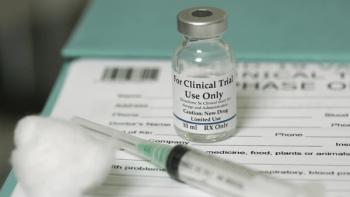
AsclepiX Therapeutics completes enrollment in DISCOVER trial for AXT107 for nAMD
The clinical-stage biopharmaceutical company has enrolled 15 participants in its study to assess the safety and tolerability of ACT107 in 3 dose strengths.
Clinical-stage biopharmaceutical company AsclepiX Therapeutics announced that enrollment has been completed for its DISCOVER trial for AXT107 (gersizangitide) for patients with neovascular age-related macular degeneration (nAMD). The trial’s primary endpoint is to evaluate the safety and tolerability of 3 dose strengths of AXT107, ranging from 125 µg (n=3), 250 µg (n=3), and 500 µg (n=9),1 cited as low, medium, and high doses in the trial,2 according to a news release. The primary endpoint will also be to determine the bioactivity and duration of action when AXT107 is injected suprachoroidally.1
“I would like to thank the team and sites for their unwavering commitment, collaborative spirit, and meticulous execution they brought to the enrollment of the DISCOVER trial,” said Robert J. Dempsey, CEO of AsclepiX Therapeutics, in the release. “Rapid enrollment was a tribute to the partnership of our principal investigators Drs David Almeida, William Bridges, Sabin Dang, and David Lally who played a critical role in achieving this significant milestone for patients.”
The company stated that 15 patients will be included in the trial, who will be injected with ACT107 and will be followed up with on regular monitoring visits through the trial’s 9 months. Inclusion criteria for participants were individuals of 50 years of age or older, BCVA in the study eye between 65 and 25 ETDRS letters (20/50 and 20/320 Snellen equivalent) at baseline on day 0, a prior partial responser to an anti-VEGF agent, and a presence of any substype of active subfoveal choroidal neovascularization (CNV) or juxtafoveal CNV with leakage affecting the fovea secondary to AMD, with the area of the CNV lesion beating 50% of the total lesion size as confirmed by the investigator, among others. Prior use of Brolucizumab, use of Aflibercept within 8 weeks, or use of Ranibizumab or Bevacizumab within 6 weeks of baseline at day 0 in the study eye, are some of the exclusion factors in the trial’s criteria.2
According to the company, AXT107 has a novel mechanism of action that inhibits neovascularization, reduces vascular permeability, and suppresses vascular inflammation. The drug is designed to maintain sustained biological activity with 1 injection and is given as a microparticulate suspension for suprachoroidal injection.1
References:
AsclepiX Therapeutics completes enrollment in DISCOVER trial for neovascular age-related macular degeneration (nAMD). News release. AsclepiX Therapeutics. May 6, 2024. Accessed May 8, 2024.
https://asclepix.com/asclepix-therapeutics-completes-enrollment-in-discover-trial-for-neovascular-age-related-macular-degeneration-namd/ AsclepiX Therapeutics. Safety and bioactivity of ACT107 in subjects with neovascular age-related macular degeneration (nAMD) (DISCOVER). ClinicalTrials.gov. NCT05859776. Updated May 6, 2024. Accessed May 8, 2024.
https://clinicaltrials.gov/study/NCT05859776?id=NCT05859776&rank=1
Newsletter
Want more insights like this? Subscribe to Optometry Times and get clinical pearls and practice tips delivered straight to your inbox.














































.png)


